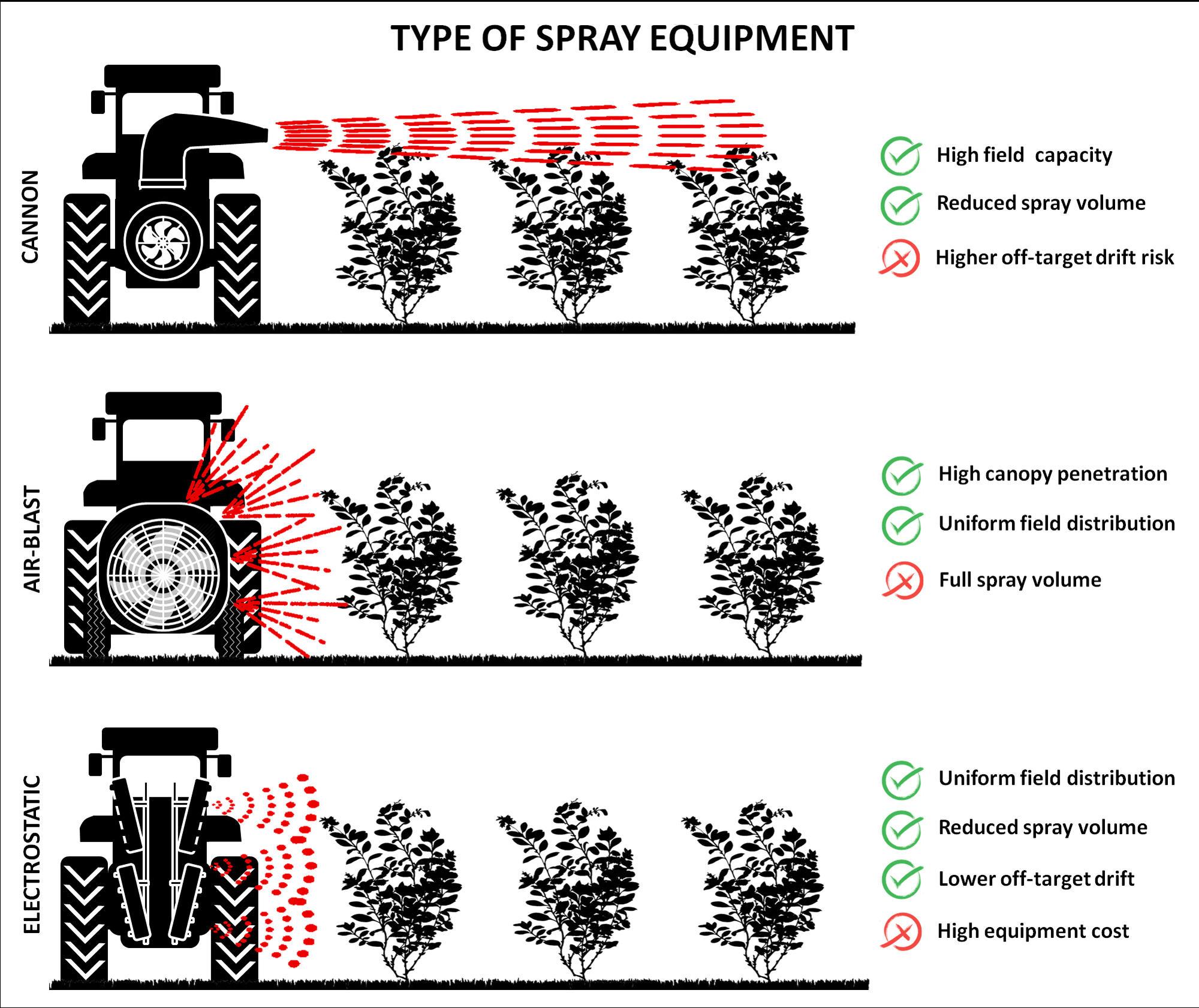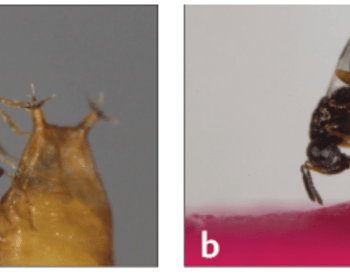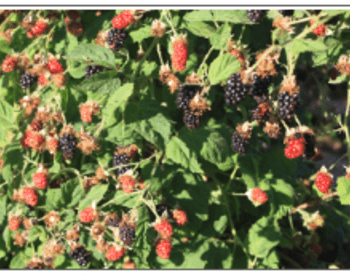SWD series #5
Key points from this fact sheet
- Most spotted-wing drosophila (SWD) are found in the center of the fruit crop canopy, where they find shade, cooler temperatures and higher humidity.
- Sprayer calibration, nozzle orientation, and adequate spray volume are key to good coverage.
- Apply sprays using appropriate tractor speeds.
- Air-blast sprayers provide consistent spray coverage.
- Cannon sprayers minimize disturbance of fruit close to harvest and cover large areas rapidly.
- Electrostatic sprayers minimize application time, non-target deposition and fruit disturbance while providing adequate coverage.
- No sprayer type provides complete coverage.
Spray equipment and crop canopy are key factors
Crop canopy and structure and the type of pesticide spray equipment help determine the effectiveness of pesticide applications. Spotted-wing drosophila lay eggs in the center of the canopy rather than in the upper and outer portions. Thick canopies impede the penetration of insecticides into this habitat, resulting in reduced control. Plants that are more heavily and appropriately pruned allow improved targeting of the interior of the canopy with the pesticide and improve pest control.
Pest control also depends on spray equipment settings and maintenance. Tractor speed, nozzle type, pressure and spray volume all affect insecticide spray efficacy. Evaluate these factors from time to time according to the size and structure of the crop. Three common types of sprayers are used in Oregon small fruit crop production: air-blast, cannon and electrostatic sprayers (Figure 1, page 2).
Cannon sprayers reduce application time and require lower spray volumes than air-blast sprayers. When used for border sprays, cannon sprayers project the chemical across the top of several crop rows from the outside of the field without covering the whole block.
Border spray programs using cannon sprayers result in similar levels of SWD control in Oregon blueberry compared to complete block applications while reducing impact to nontarget arthropods.
However, cannon sprayers may result in irregular spray deposition and increased off-target drift under windy conditions. Irregular deposition patterns may reduce control when SWD pressure is high.
Air-blast sprayers rely on rapid airflow for more uniform deposition of pesticide on all surfaces throughout the canopy. In recent tests, air-blast sprayers increased spray deposition on Oregon blueberry on the lower part of the canopy. This could be because the axial fan circulates the air from the bottom to the top of the canopy. Orienting the nozzle to provide adequate coverage optimizes the deposition pattern within the canopy. Nozzles should be checked and serviced annually.
Electrostatic sprayers deliver pesticides to hard-to-reach locations within the canopy. The electrically charged droplets are drawn to the oppositely charged plants. This reduces off-target product losses to the air and ground and delivers more uniform canopy coverage. It is possible for high humidity to negatively affect coverage uniformity and adequacy. This equipment will likely cost more than air-blast and cannon sprayers.
Further reading
Diepenbrock, L. M., H.J. Burrack. 2016. Variation of within-crop microhabitat use by Drosophila suzukii (Diptera: Drosophilidae) in blackberry. Journal of Applied Entomology. 141: 1–7.
Klick, J., W.Q. Yang, J.C. Lee, D.J. Bruck. 2016. Reduced spray programs for Drosophila suzukii management in berry crops. International Journal of Pest Management. 62(4): 368–377.
Khot, L.R., R. Ehsani, G. Albrigo, P.A. Larbi, A. Landers, J. Campoy, C. Wellington. 2012. Air-assisted sprayer adapted for precision horticulture: Spray patterns and deposition assessments in small-sized citrus canopies. Biosystems Engineering. 113, 76–85.
Singh, M., C. Ghanshyam, P.K. Mishra, R. Chak. 2013. Current status of electrostatic spraying technology for efficient crop protection. AMA, Agricultural Mechanization in Asia, Africa and Latin America. 44: 46–53.
VanEe, G., L.R. Ledebuhr, E. Hanson, J. Hancock, D.C. Ramsdell. 2000. Canopy development and spray deposition in highbush blueberry. HortTechnology 10: 353–359.
Mermer, S., F. Pfab, G.A. Hoheisel, H.Y. Bahlol, L. Khot, D.T. Dalton, L.J. Brewer, M.V. Rossi-Stacconi, C. Zhang, L. Xue, V.M. Walton. Canopy spray deposition and related mortality impacts of commonly used insecticides on Drosophila suzukii Matsumura (Diptera: Drosophilidae) populations in blueberry. Pest Management Science. https://doi.org/10.1002/ps.5672.
About this series
This publication is one of a series of nine publications focused on strategies for controlling spotted-wing drosophila in Oregon. Find them at https://catalog.extension.oregonstate.edu/. The publications in this series include:
- EM 9261: How Seasons Affect Population Structure, Behavior and Risk on Spotted-wing Drosophila
- EM 9262: Cultural Control Strategies to Manage Spotted-wing Drosophila
- EM 9263: Host Range and Characteristics Affecting Fruit Susceptibility to Spotted-wing Drosophila
- EM 9264 Noncrop Host Plants Used By Spotted-wing Drosophila
- EM 9265: Chemical Control of Spotted-wing Drosophila: Spray Applications
- EM 9266: Chemical Control of Spotted-wing Drosophila: Insecticide Efficacy
- EM 9267: Monitoring Techniques for Spotted-wing Drosophila
- EM 9268: Potential Impacts of Irrigation on Biocontrol on Spotted-wing Drosophila Populations
- EM 9269: Biocontrol of Spotted-wing Drosophila
© 2019 Oregon State University.





